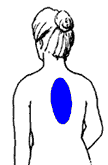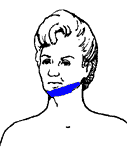MedlinePlus Topics
Heart Attack
Images
Heart attack symptoms
Symptoms of heart attack
Read More
Breathing - slowed or stopped
Heart attack A heart attack is a medical emergency.
The average person waits 3 hours before seeking help for symptoms of a heart attack. Many heart attack victims die before they reach a hospital. The sooner someone gets to the emergency room, the better the chance of survival. Prompt medical treatment also reduces the amount of damage done to the heart following an attack.
Considerations
Heart disease is the leading cause of death in America today.
Causes
A heart attack occurs when the blood flow that carries oxygen to the heart is blocked. The heart muscle becomes starved for oxygen and begins to die. See heart attack for more specific causes.
Symptoms
Heart attacks can cause a wide range of symptoms, from mild to intense. Women, the elderly, and people with diabetes are more likely to have subtle or unusual symptoms.
Symptoms in adults may include:
Altered mental status, particularly in the elderly
Chest pain
Usually in the center of the chest
Lasts for more than a few minutes or comes and goes
May feel like pressure, squeezing, fullness
Pain may be felt in other areas of the upper body, such as the jaw, shoulder, one or both arms, back, and stomach area
Cold sweat
Light-headedness
Nausea
Numbness, aching, or tingling in the arm (usually the left arm)
Shortness of breath
Weakness or fatigue, particularly in the elderly
Women are more likely than men to have symptoms of nausea, vomiting, fatigue, back or jaw pain, and shortness of breath, either alone or with chest pain.
Babies and children may appear limp and unresponsive and may have bluish-colored skin.
First Aid
Have the person sit down, rest, and try to keep calm.
Loosen any tight clothing.
Ask if the person takes any chest pain medication for a known heart condition.
Help the person take the medication (usually nitroglycerin, which is placed under the tongue).
If the pain does not go away promptly with rest or within 3 minutes of taking nitroglycerin, call for emergency medical help.
If the person is unconscious and unresponsive, call 911 (or your local emergency number), then begin CPR.
If an infant or child is unconscious and unresponsive, perform 1 minute of CPR, then call 911.
DO NOT
Do NOT leave the person alone except to call for help, if necessary.
Do NOT allow the person to deny the symptoms and convince you not to call for emergency help.
Do NOT wait to see if the symptoms go away.
Do NOT give the person anything by mouth unless a heart medication (such as nitroglycerin) has been prescribed.
When to Contact a Medical Professional
If an adult or child is unresponsive or is not breathing.
If sudden chest pain or other symptoms of a heart attack occur.
Prevention
Adults should take steps to control heart disease risk factors whenever possible.
If you smoke, quit. Smoking more than doubles the chance of developing heart disease.
Keep blood pressure, cholesterol, and diabetes in good control and follow your doctor's orders.
Lose weight if obese or overweight.
Get regular exercise to improve heart health. (Talk to your doctor before starting any new fitness program.)
Eat a heart-healthy diet. Limit saturated fats, red meat, and sugars. Increase your intake of chicken, fish, fresh fruits and vegetables, and whole grains. Your health care provider can help you tailor a diet specific to your needs.
Limit the amount of alcohol you drink. One drink a day is associated with reducing the rate of heart attacks, but two or more drinks a day can damage the heart and cause other medical problems.
Alternative Names
First aid - heart attack; First aid - cardiopulmonary arrest; First aid - cardiac arrest
References
Hollander JE. Acute coronary syndromes. Acute myocardial infarction and unstable angina. In: Tintinalli JE, Kelen GD, Stapczynski JS, Ma OJ, Cline DM, eds. Emergency Medcinie: A Comprehensive Study Guide. 6th ed. New York, NY:McGraw-Hill;2004:chap 50.
Anderson JL, Adams CD, Antman EM, Bridges CR, Califf RM, Casey DE Jr., et al. ACC/AHA 2007 guidelines for the management of patients with unstable angina/non-ST-elevation myocardial infarction: a report of the American College of Cardiology/American Heart Association Task Force on Practice Guidelines (Writing Committee to Revise the 2002 Guidelines for the Management of Patients with Unstable Angina/Non-ST-Elevation Myocardial Infarction) developed in collaboration with the American College of Emergency Physicians, the Society for Cardiovascular Angiography and Interventions, and the Society of Thoracic Surgeons endorsed by the American Association of Cardiovascular and Pulmonary Rehabilitation and the Society for Academic Emergency Medicine. J Am Coll Cardiol. 2007;50:e1-e157.
Update Date: 7/8/2009
Updated by: Jacob L. Heller, MD, MHA, Emergency Medicine, Virginia Mason Medical Center, Seattle, Washington, Clinic. Also reviewed by David Zieve, MD, MHA, Medical Director, A.D.A.M., Inc.




